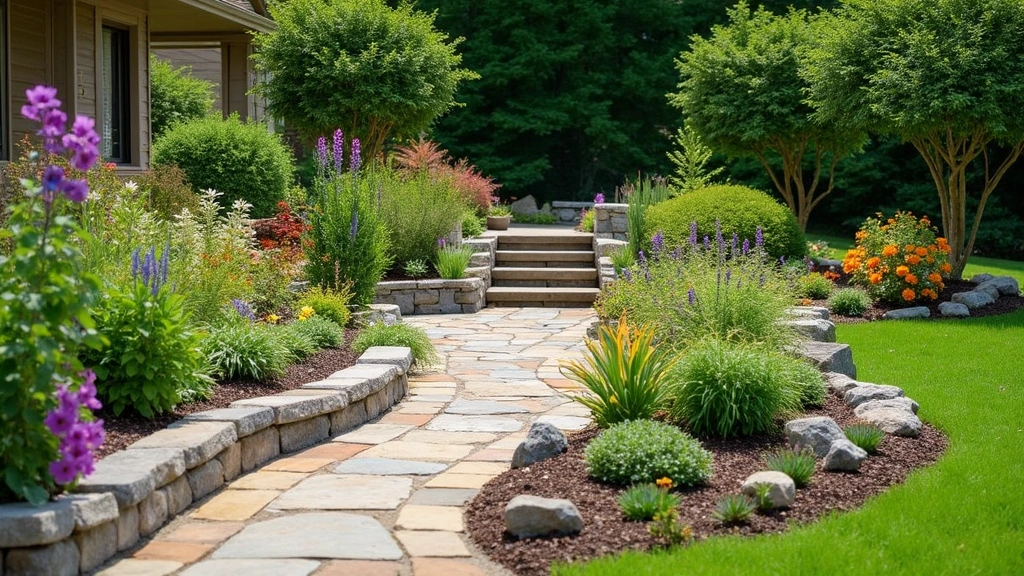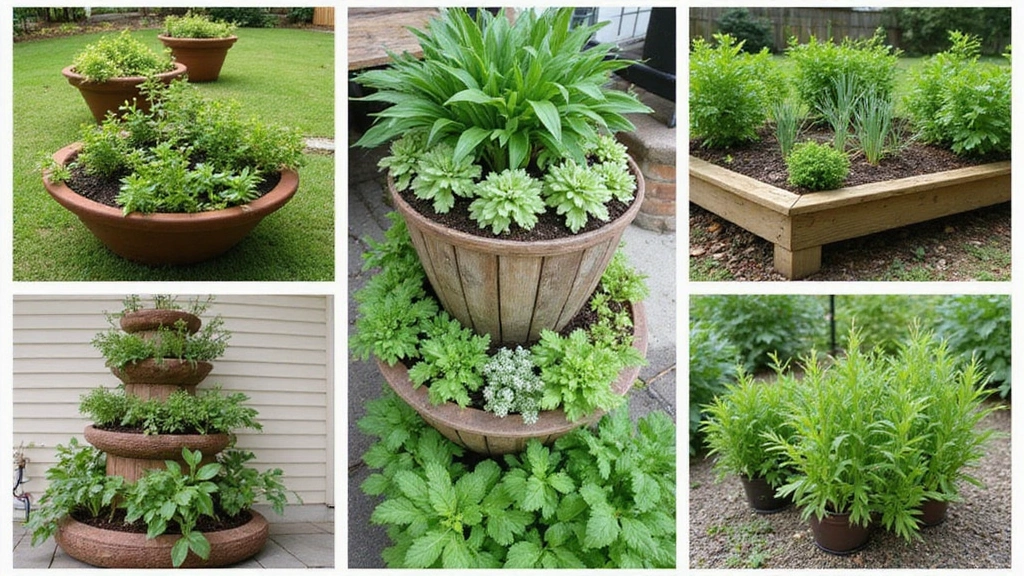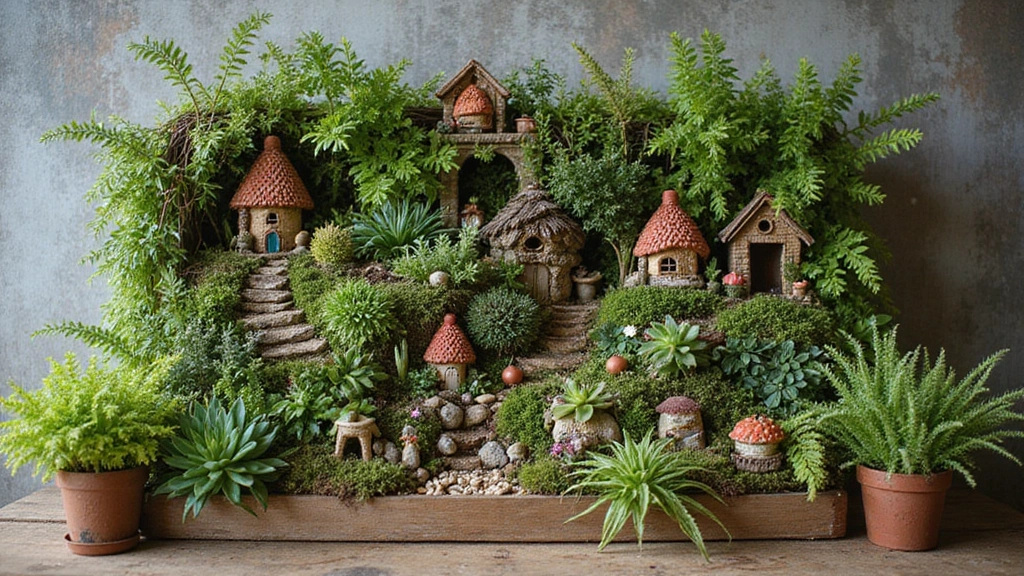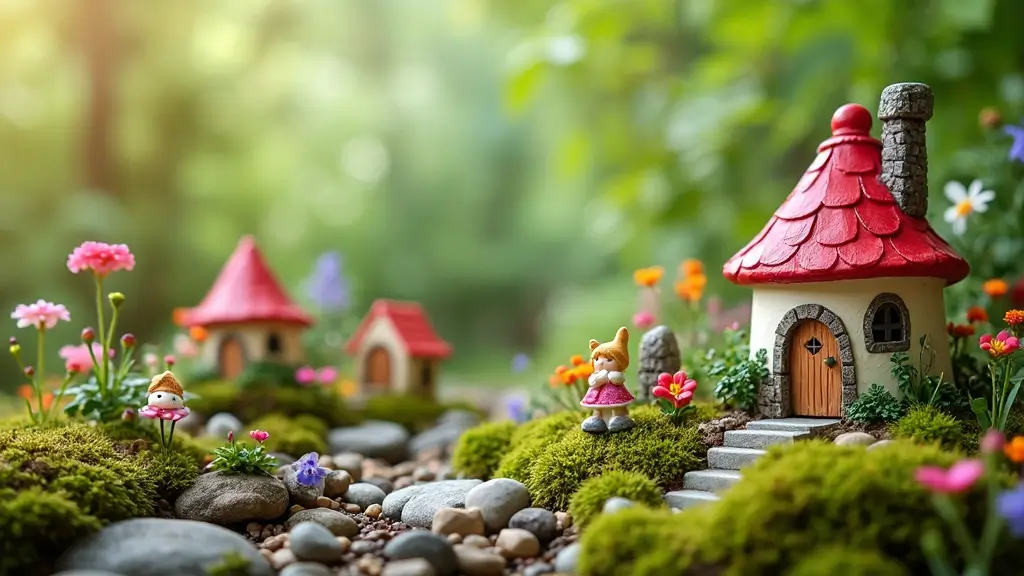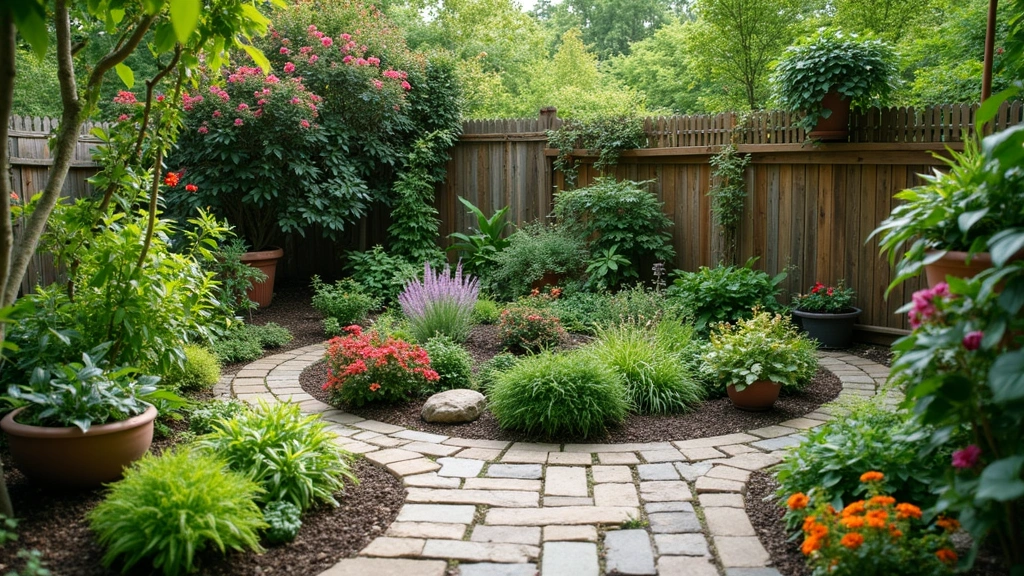Creating a beautifully defined garden is all about the details, and nothing highlights your gardening efforts quite like the perfect edging. From rustic wood to chic metal, there are countless garden edging ideas that can transform your outdoor space into a visual delight.
Not only does edging serve a practical purpose by keeping soil and plants in their designated spaces, but it also enhances the overall aesthetic of your garden. Whether you have a sprawling backyard or a cozy balcony, these 25 inspiring ideas will help you create defined zones and a polished look.
So, if you’re ready to elevate your garden’s design, keep reading for a treasure trove of creative ideas that will surely ignite your landscaping imagination.
1. Charming Stone Borders
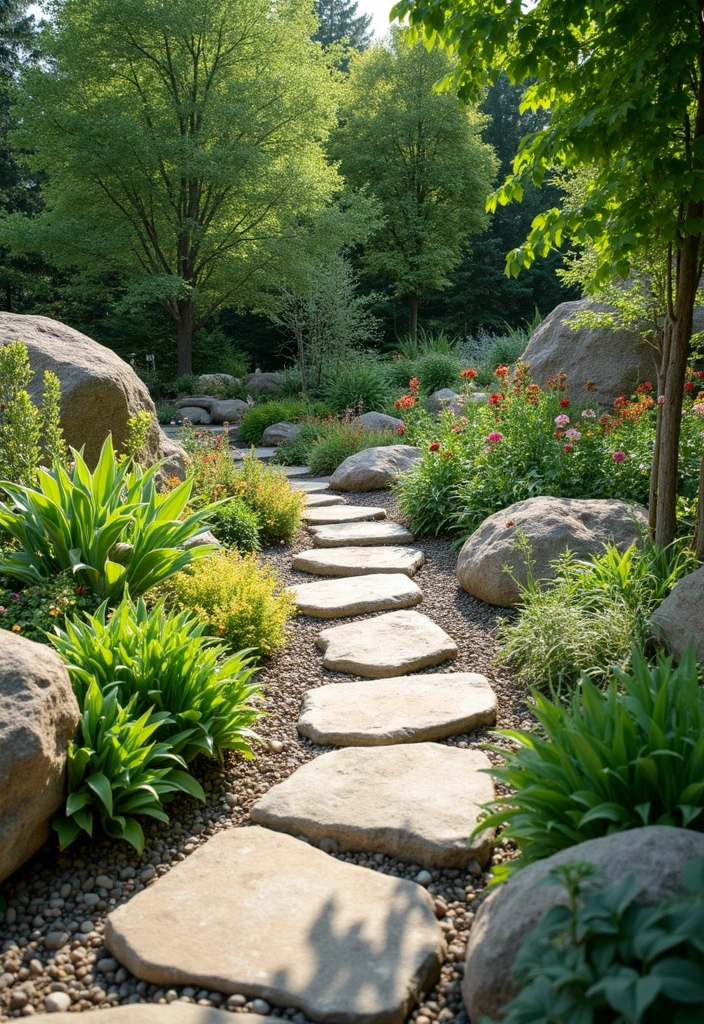
Stone borders add a timeless elegance to any garden, creating a natural, rustic feel. Whether you opt for smooth river stones or rugged boulders, these elements seamlessly blend into the landscape. To get started, consider using natural river stones, which come in a variety of sizes and shapes to suit your design needs. These decorative river rocks are perfect for lining a walkway, defining flower beds, or even creating a serene pathway, helping to keep mulch in place while adding aesthetic appeal.
For a more casual look, mixing different stone sizes creates an organic appearance. Select stones that complement your home’s architecture for a cohesive look, choosing natural stones in earthy tones to enhance your garden’s charm. If you’re looking for an easy-to-install option, consider garden edging stones. This no-dig landscape edging comes with anchoring spikes, allowing you to create clean, decorative borders with minimal effort.
You can also experiment by using gravel for landscaping between larger stones for a polished finish that also aids in drainage. Maintenance is minimal; simply remove any weeds that pop up, and you can easily enjoy the beauty of nature.
2. Magical Metal Edging
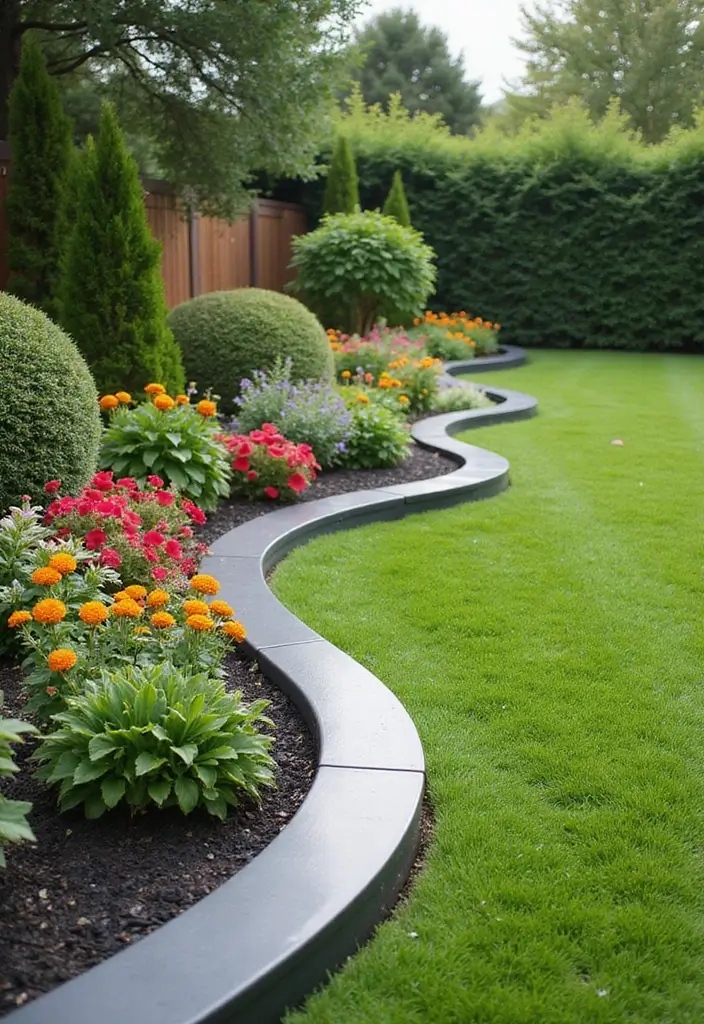
Metal edging is ideal for a sleek, modern garden design. Available in various finishes, from shiny aluminum to rustic corten steel, it offers durability and elegance.
For instance, the galvanized steel garden edging is a fantastic option that creates clean lines around garden beds or pathways, providing a striking contrast against soil and plants. This type of edging not only enhances your garden’s aesthetics but also helps maintain a tidy appearance with minimal effort.
If you prefer aluminum, consider the aluminum landscape edging, which is lightweight yet sturdy, making installation a breeze. Its reflective quality can enhance the light in your garden, creating a stunning visual effect while ensuring your garden stays beautifully defined.
For a unique twist, the copper garden edging develops a charming patina over time, adding character to your space. Beyond aesthetics, metal edging is effective at deterring pests and keeping your lawn edges sharp, proving to be a versatile choice that works in both contemporary and traditional settings.
3. Whimsical Wooden Planks
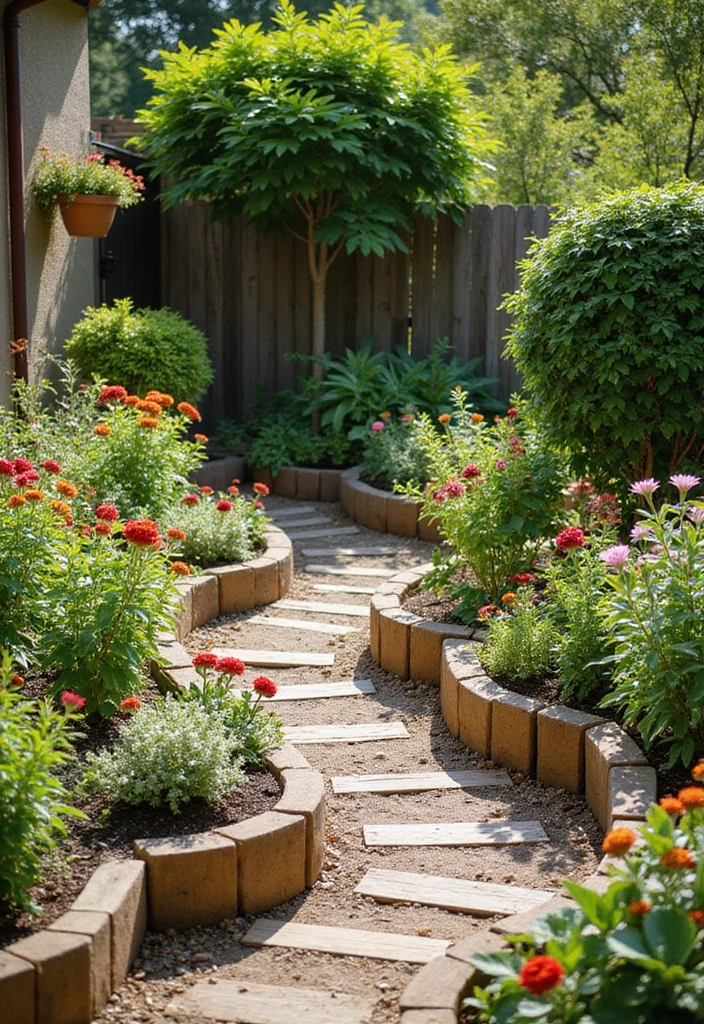
Wooden planks bring warmth and charm to any garden layout. You can choose reclaimed wood for a rustic vibe or new timber for a polished look. To enhance your wooden edging, consider treating it with Non-Toxic Wood Sealant, a linseed oil and beeswax blend that will provide long-lasting durability while keeping your garden safe for kids and pets.
Arrange the planks vertically or horizontally to define borders or create raised beds. One unique idea is to create a zigzag pattern for a playful touch, adding visual interest. For a more sustainable approach, look for FSC-Certified Wooden Planks, which promote responsible forestry practices.
Additionally, wooden edging can be painted or stained in various colors to match your garden’s personality. A great option for this is Outdoor Wood Paint or Stain, which is designed to withstand the elements and resist scratches. Just be sure to keep an eye on potential splinters and wear, ensuring it’s safe for everyone to enjoy.
4. Colorful Brick Paths
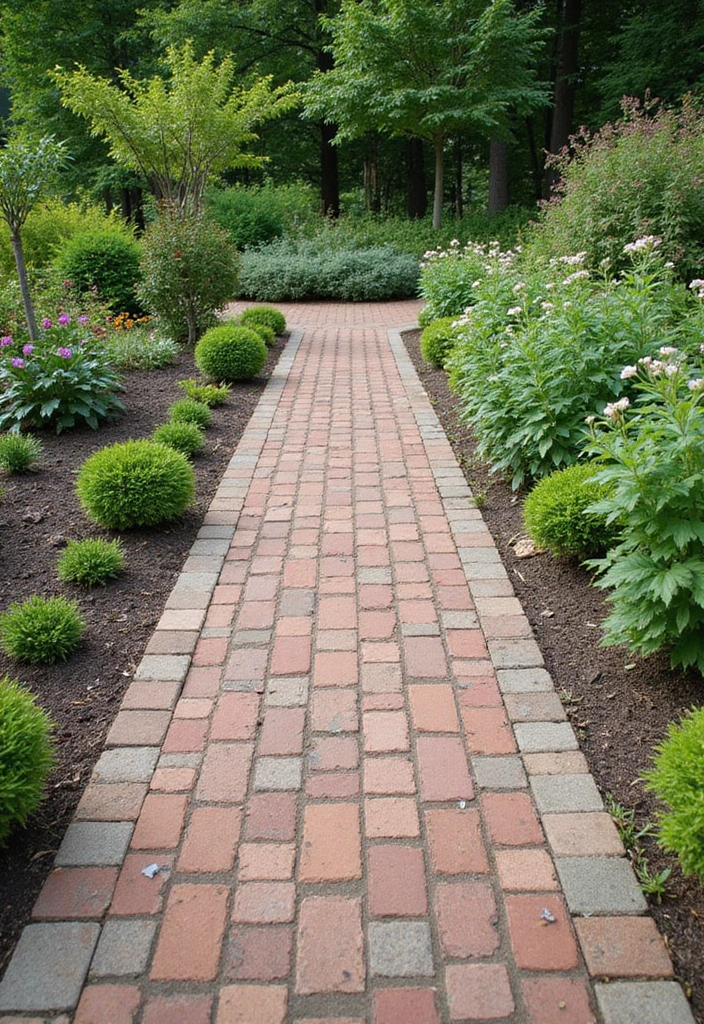
Brick edging offers a classic and durable solution for defining your garden edges. With a variety of colors and patterns, bricks can be arranged in creative ways to suit any garden style. Set them in a straight line for a more formal look, or create a herringbone pattern for something more intricate. This not only helps to keep weeds at bay but also provides a stable base for walkways and borders.
To make the installation process easier, consider using a brick edging kit. This kit comes with flexible blocks and spikes, making it a hassle-free option for your lawn edging and flower beds.
Regular cleaning and maintenance are key to keeping the bricks looking fresh over time. For sealing and protecting your brickwork, outdoor sealant for bricks is a great choice. This sealant will help prevent damage from moisture and extend the life of your edging.
You can also play with different types of bricks—such as reclaimed or handmade—for added character. Additionally, consider integrating plants like creeping thyme in between the bricks. This ground cover not only softens the edges but also adds a lush, green effect, enhancing the overall look of your garden.
5. Natural Bamboo Fencing

Bamboo fencing is an eco-friendly and stylish option for garden edging. It provides a soft, organic feel while still offering a clear border for your plants. You can use bamboo poles vertically for a fence-like look, or lay them flat for a more subtle boundary. This option works wonderfully in tropical or Asian-inspired gardens, creating a serene atmosphere.
To maintain durability, it’s important to treat your bamboo with a quality sealant. Consider using Bamboo Sealant and Oil Treatment. This premium water-base sealant not only waterproofs your bamboo but also offers UV protection, helping to preserve its integrity against the elements.
For added stability, bury part of the bamboo in the ground. If you’re looking for a quick and easy setup, Natural Bamboo Fencing Rolls can provide an instant solution, allowing you to define your garden space effortlessly.
Consider mixing different heights of bamboo for added interest, and use it to create a natural backdrop for taller plants or sculptures in your garden. With the right products, you can ensure your bamboo fencing remains beautiful and durable for years to come.
6. Eclectic Recycled Materials
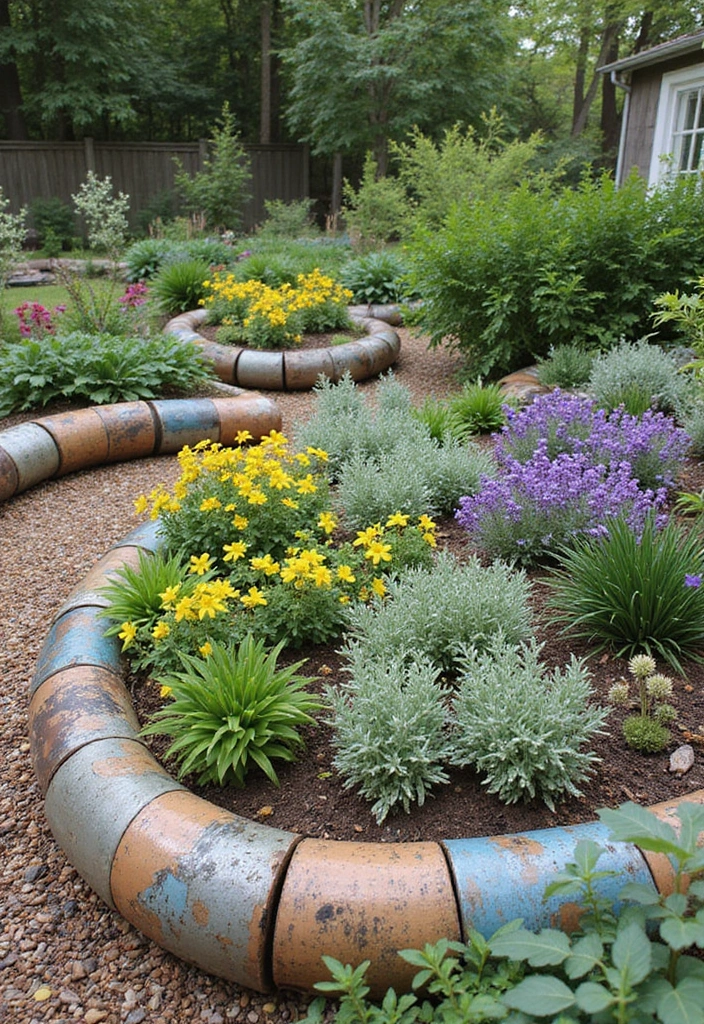
Using recycled materials for garden edging not only adds character but also promotes sustainability. From old tires painted in vibrant colors to stacked broken bricks or concrete pieces, the possibilities for creativity are endless.
For instance, you can transform old tires with a splash of color using paint for outdoor tires, making them striking features for raised beds. This not only saves money but also allows your unique design to shine through.
Searching local thrift shops or online marketplaces can yield items that are ripe for upcycling into beautiful edging. Consider using a recycled brick edging system that adds a polished look while being environmentally friendly.
For an artsy touch, you might enjoy creating mosaic patterns with broken tiles. A great starting point is a mosaic tile kit, perfect for crafting stunning borders that are truly one-of-a-kind. This approach captures the essence of eclectic style while enhancing the charm of your garden space.
7. Soft Curved Edging
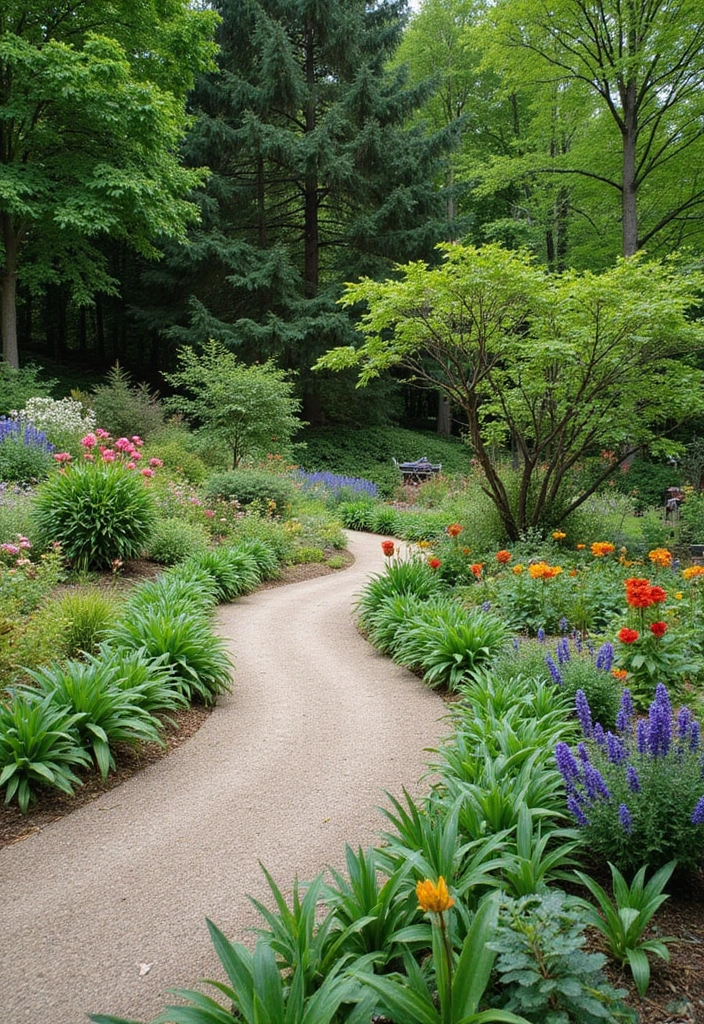
Soft curved edging creates a relaxed look that enhances the natural flow of your garden. Instead of rigid lines, consider using materials like flexible plastic or rubber that can bend and create gentle curves. For instance, Amazon Basics landscape edging coil offers a versatile solution with its flexible design, allowing you to shape your garden’s borders with ease.
This approach is particularly effective in larger gardens where straight edges can feel too harsh. You can create meandering paths or rounded borders that invite exploration. To help mark out your desired curves before installation, a practical tool like the Stanley FATMAX professional grade garden hose can be invaluable. Using a garden hose to visualize the flow lets you make adjustments as needed, ensuring that your edging complements the overall design of your space.
Curved edges also allow for planting beds to be more expansive, creating a lush, layered look with various heights of plants for added visualization. For a more durable option, consider the L No-Dig rubber landscape edging, which provides a long-lasting solution that holds its shape beautifully while offering a natural appearance. Embracing these products will help you achieve the soft curves and inviting flows that enhance your garden’s aesthetic.
8. Elegant Glass Edging
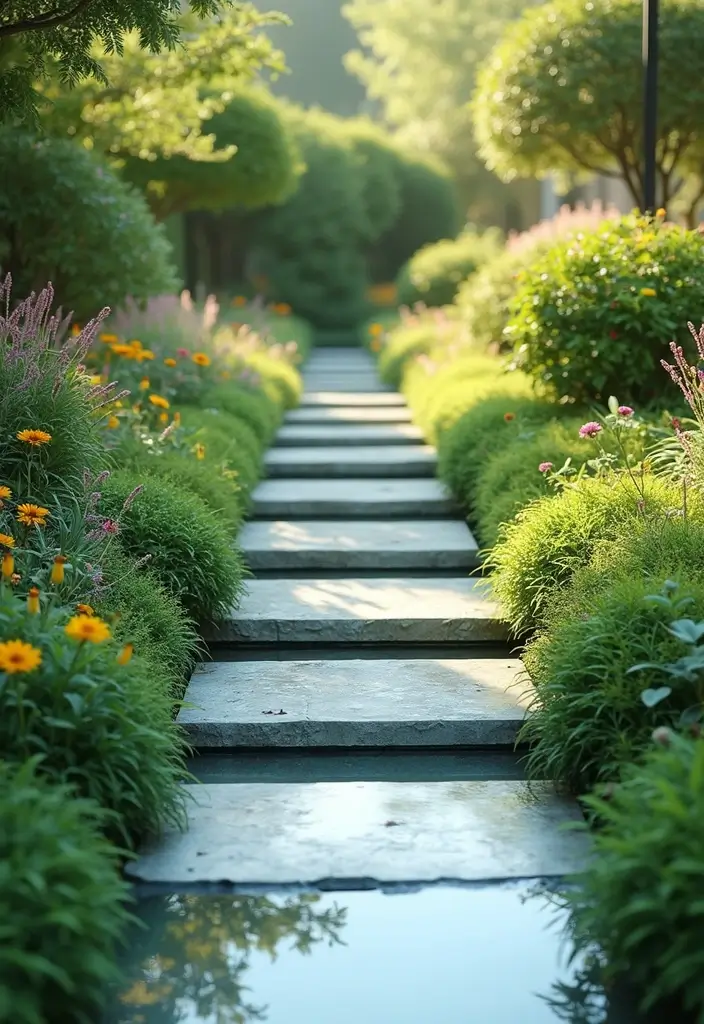
Glass edging introduces a sophisticated touch to modern gardens. Use tempered glass panels for a sleek look that reflects light beautifully, adding depth to your garden. These panels not only provide a clean and elegant border but also allow plants to shine without obstruction. For a seamless installation, consider the tempered glass garden edging panels, which are an excellent choice for contemporary designs where clean lines are essential.
Ensure that the glass is securely installed to prevent tip-overs, especially in areas with foot traffic. Pairing your glass edging with a garden edging installation kit can provide the stability needed for your setup, featuring flexible plastic edging and spikes for easy, no-dig installation.
To add a pop of color, consider using colored glass pieces that can catch the eye and enhance the ambiance, providing a unique twist to traditional garden designs. The colored glass decorative stones make for a delightful addition; their vibrant hues can beautifully complement your glass edging while adding an artistic flair to your garden space.
9. Charming Picket Fences
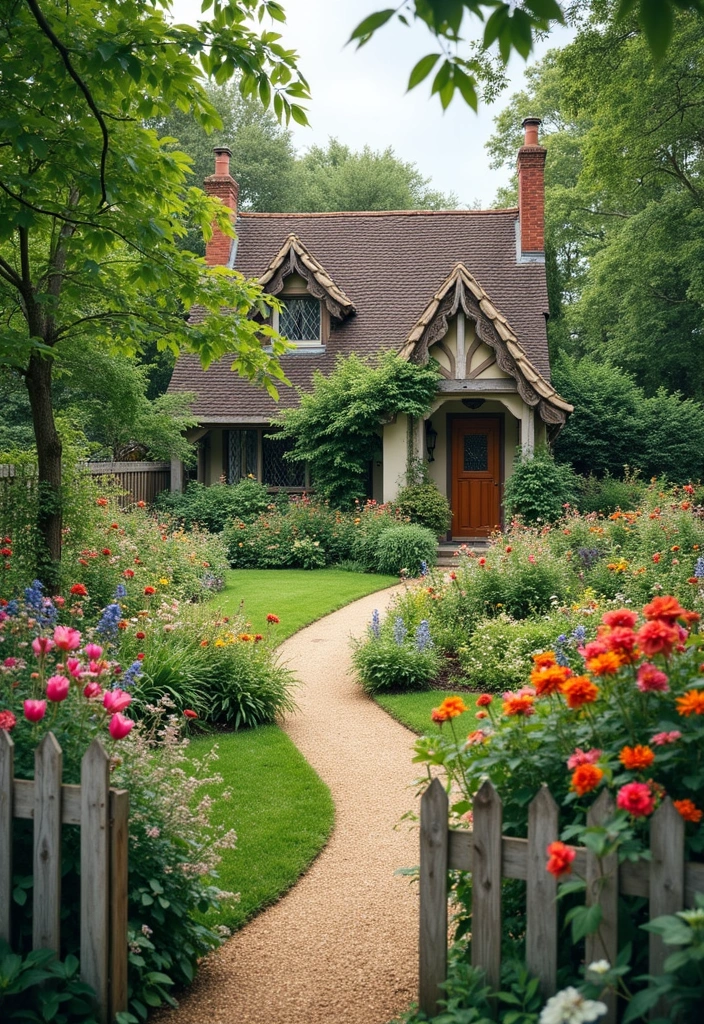
Picket fences evoke a classic, cottage garden feel that can beautifully define your space. While traditionally used as enclosures, they can also serve as tasteful garden borders. For instance, the Wooden Picket Fence Panels offer a charming option, and with a pack of 12, you can easily create a cozy, defined area in your garden.
You can paint them in pastel colors for a whimsical look or opt for natural wood for a rustic touch. Picket fences work great to keep pets contained while allowing visibility into your garden, enhancing the overall appeal of your outdoor space. Consider adding climbing plants or hanging pots to the fence for extra interest. The Hanging Planters are perfect for this purpose, providing a lovely way to showcase your greenery while saving space.
This border can also serve as an excellent backdrop for seasonal decorations or garden art. To keep your picket fence looking fresh and maintained, use products like Outdoor Wood Stain, which will enhance longevity and ensure the wood remains vibrant through the seasons. With these thoughtful additions, your charming picket fence can become a delightful feature of your garden.
10. Textured Cinder Blocks
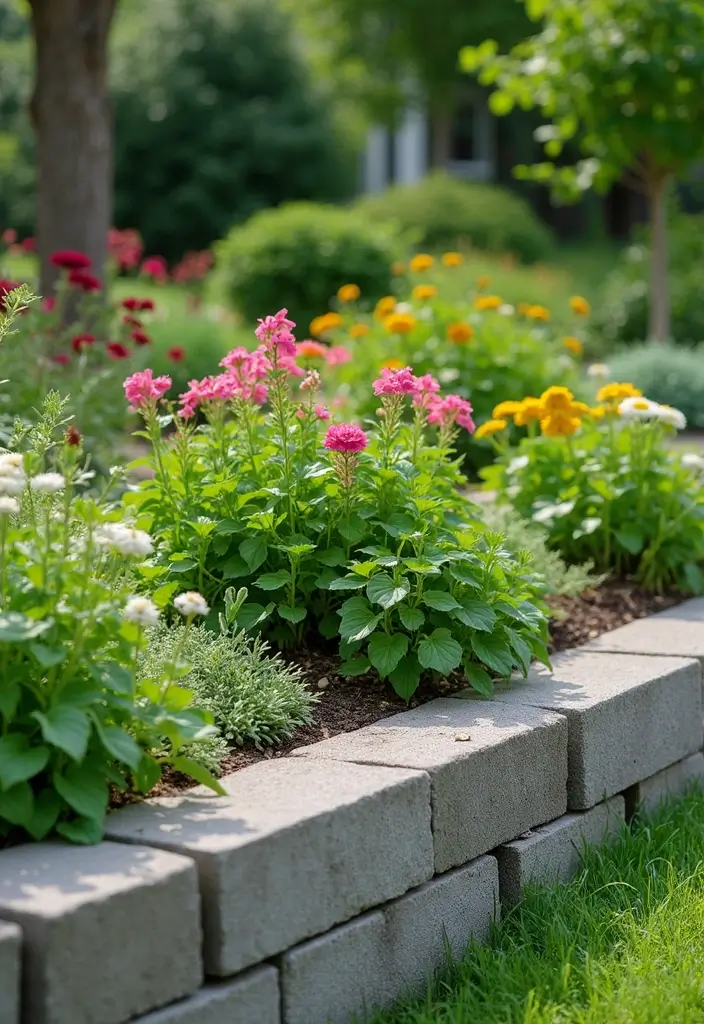
Cinder blocks offer a unique textured option for garden edging while providing functionality. They can easily be stacked to create raised beds or arranged to form a border around flower beds. To get started, check out these solid cinder blocks, which are sturdy and perfect for your garden projects.
You can choose to leave some blocks empty for planting smaller flowers or herbs, creating an interesting interactive edge to your garden. This approach is particularly great for urban gardens where vertical space is at a premium. Adding a splash of color can enhance the aesthetics, so consider using outdoor-rated paint. A great option is the Rust-Oleum Painter’s Touch Ultra Cover, which allows you to paint the blocks in cheerful colors or create patterns that reflect your personality.
Finally, if you’re looking to maintain your garden’s structure, using edging tools is essential. The edger lawn tool is ideal for defining paths and making it easy to separate areas in your garden, ensuring that your design remains clean and organized.
You might also like
11. Playful Pebbles and Gravel

Pebbles and gravel provide a fun and flexible edging solution that can enhance the charm of your garden. These materials can be scattered around pathways or used to create borders, adding a rugged appeal while being budget-friendly and low maintenance. Available in various sizes and colors, you can combine pebbles with larger rocks for depth or mix colors for a more dramatic effect.
To get started, consider using decorative garden pebbles, which are perfect for landscaping your flower beds or creating striking borders. These pebbles not only look great but also allow for excellent drainage and weed control.
Before laying down your pebbles, it’s wise to outline your garden edges with landscape fabric roll. This heavy-duty weed barrier will help prevent unwanted plants from breaking through, ensuring your garden maintains its neat appearance.
For a truly unique aesthetic, think about mixing pebbles with concrete to create a textured path. Using concrete mix for garden projects can yield a stylish solution that feels both natural and sophisticated. Embrace creativity with these materials and watch your garden come alive!
12. Artistic Mosaic Edging
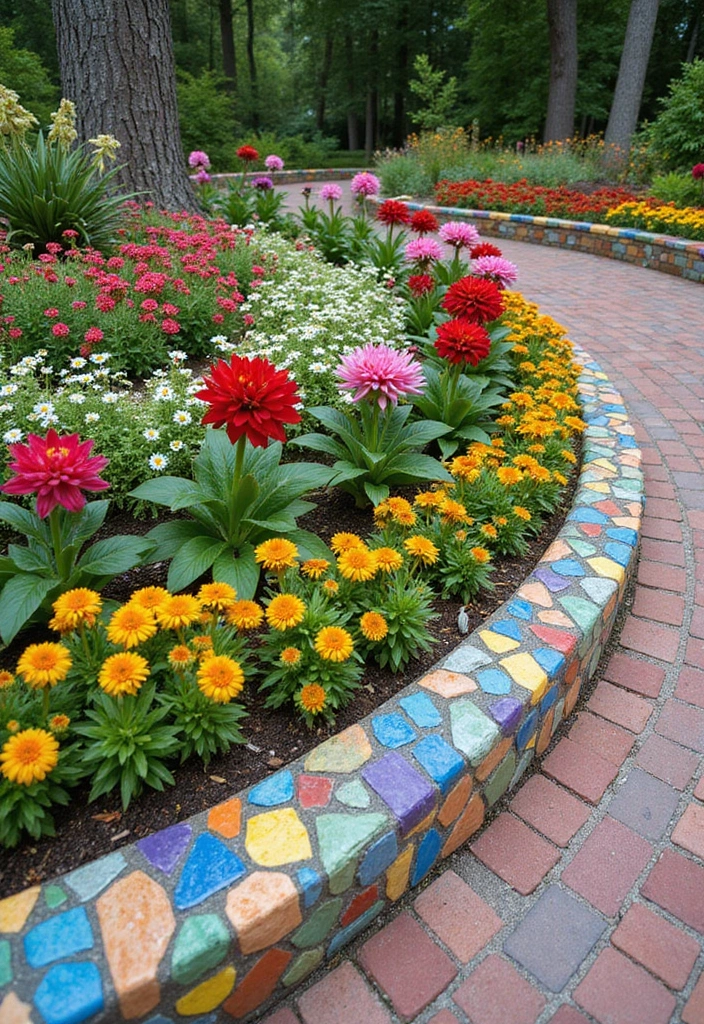
Mosaic edging involves using pieces of tiles, glass, or stones to create beautiful patterns along your garden edges. This creative method adds flair to any garden, showcasing your artistic side.
You can lay out intricate designs that reflect your style—be it floral patterns or geometric shapes—turning your garden into a vibrant canvas. Mosaic edging can also work well in a variety of settings, from whimsical gardens to contemporary landscapes.
To get started, consider using mosaic tile pieces, such as the Lanyani 1050 pieces mixed shapes glass mosaic tiles, which offer a colorful array for your projects. These stained glass pieces can bring your artistic vision to life.
When it comes to securing your mosaic design, a reliable adhesive is key. Use waterproof adhesive for outdoor use, such as Gorilla Max Strength Construction Adhesive. Its gap-filling properties ensure that your mosaics stay firmly in place, even in varying weather conditions.
For a polished look, consider incorporating some natural elements with garden edging stones like the EasyFlex No-Dig Landscape Edging Kit. This decorative stone-look border not only enhances your design but also defines the garden space beautifully.
Engaging in this mosaic project is not only beautiful but can also be a fun activity that involves family and friends, making your garden a true reflection of your creativity.
13. Minimalist Concrete Edging
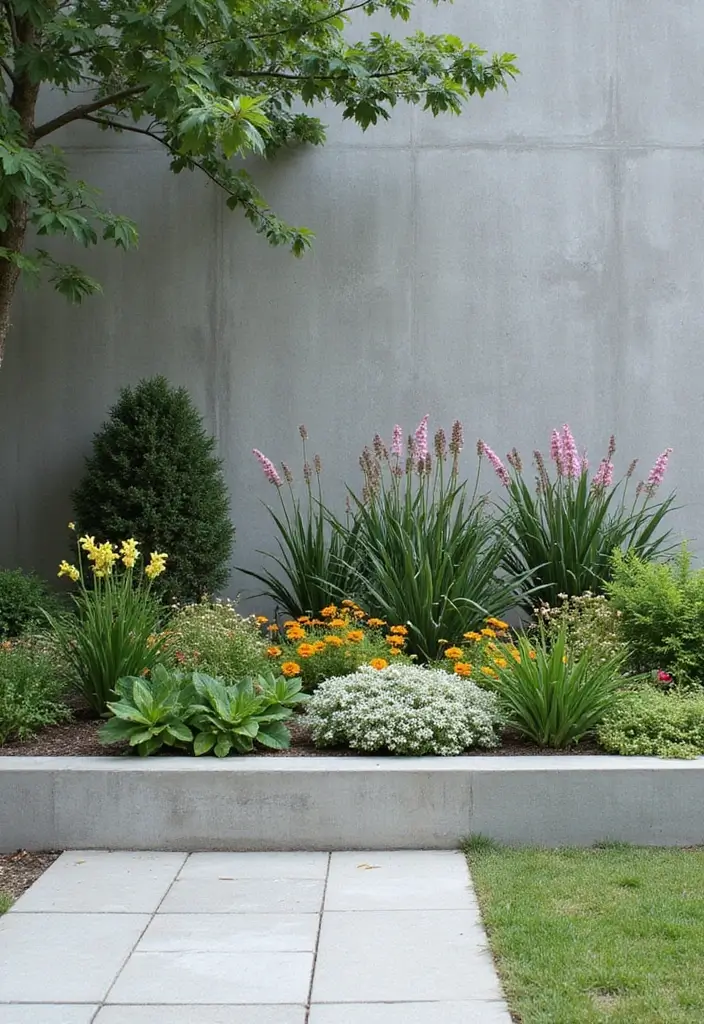
Concrete edging offers a sleek and modern approach to defining garden spaces. You can cast your concrete into various shapes, allowing for creative designs that suit your landscape’s theme.
Consider using straight lines for a more minimalist look or curved shapes for a softer touch. For those looking to create unique forms, concrete edging forms are an excellent option, providing four flexible pieces to help you shape your borders precisely. This durable option can withstand the elements while providing a clean, polished appearance to your garden borders.
To enhance the visual appeal of your concrete, consider adding texture with a concrete stamp set. The realistic detail from the decorative tile patterns can add a distinctive touch to your edging, making it stand out even further. Additionally, using concrete stain allows you to infuse color into your edging, giving you the opportunity to customize your garden’s aesthetic while providing a beautiful backdrop for colorful plants that will pop against the neutral concrete tones.
14. Bright Colored Planters
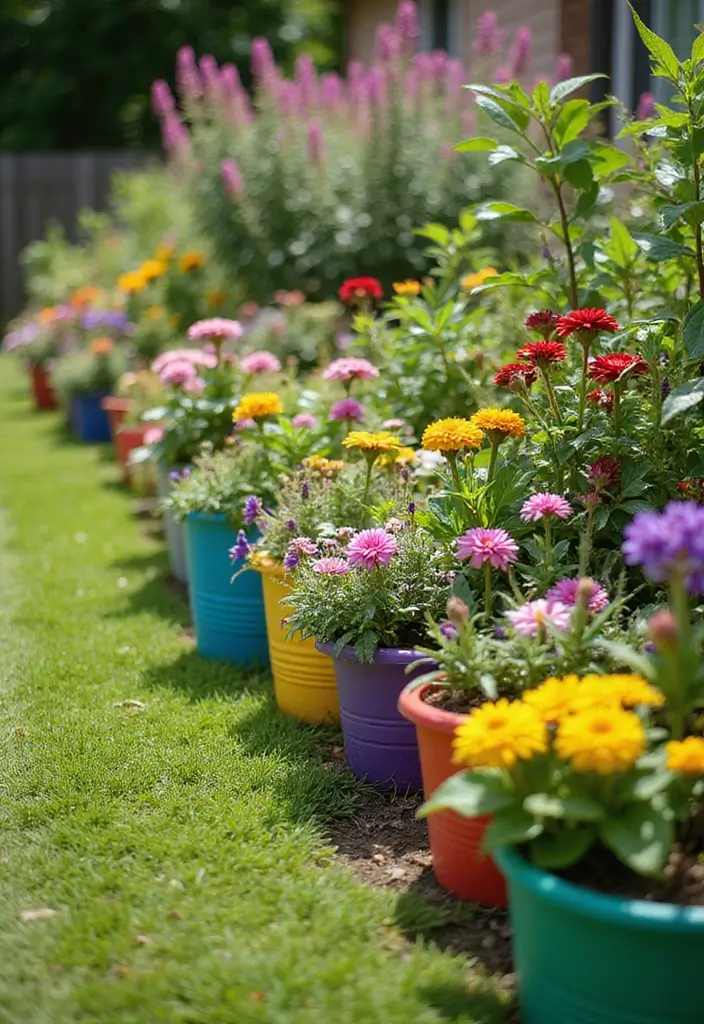
Colored planters can double as garden edging while providing space for additional plant life. Arrange different-sized pots along garden borders not only to separate areas but to add color and texture. For instance, you can use colorful ceramic planters from Ton Sin, which feature vibrant gold hues ideal for brightening up your garden. This approach makes it easy to customize your garden design based on seasonal blooms or personal style.
Consider using a mix of styles, such as terracotta plant pots for a classic look paired with the more modern ceramic pots. Mixing heights and styles can create a lively environment that’s full of personality. Furthermore, using pots with drainage holes, like the ones found in self-watering planters, ensures healthy plant growth.
To make your garden both functional and beautiful, consider using these pots for herbs or vegetables, creating an edible border that enhances your outdoor space.
15. Vintage Railway Sleepers

Railway sleepers offer a rustic and sturdy option for garden edging. These large wooden beams add an old-world charm and can be stacked to create raised beds or used as flat borders. To enhance their weathered appearance, consider adding a layer of garden mulch, which not only looks visually appealing but also conserves moisture and suppresses weeds.
The contrast between the sleepers and lush greenery can create a stunning visual in your garden. You can use them to outline paths, steps, or even create tiered planting areas for added interest. Ensure that the wood is treated for longevity, especially if you’re using them in direct contact with soil. By placing soil or mulch on top, you enhance the natural look and functionality of the area.
Additionally, if you’re bringing definition to larger spaces, the weight of the railway sleepers can be an excellent choice for creating a grand garden design. For those looking for an alternative edging solution, consider the garden edging stones, which offer a decorative stone-look finish while being easy to install without digging, providing a neat border that complements the rustic appeal of the railway sleepers.
16. Versatile Landscape Fabric
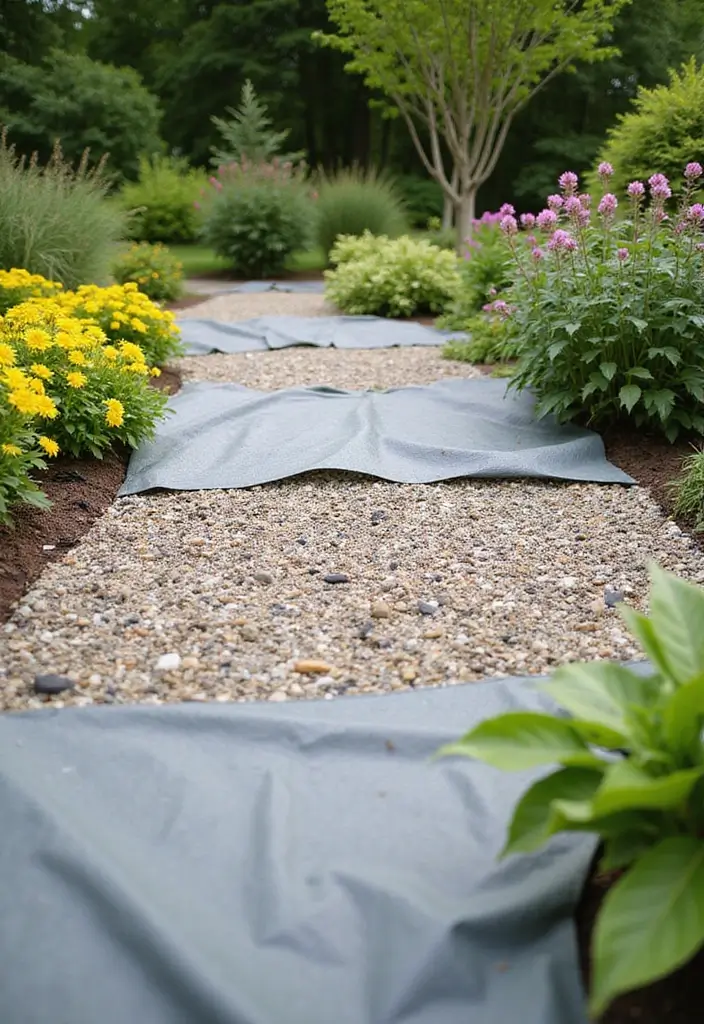
Landscape fabric is another lesser-known option that offers a practical solution for garden edging. Although it might not seem decorative, hiding it beneath a layer of decorative gravel or mulch can effectively define your spaces. This option is excellent for preventing weed growth while still allowing water and nutrients to reach your plants.
To get started, consider using a landscape fabric roll. This heavy-duty, woven weed barrier not only provides a solid underlayment for your garden but also gives you the flexibility to create curved or straight edges, tailoring it to fit any space.
Once you’ve laid down the fabric, layer it with decorative gravel or mulch to improve aesthetics. Using polished stones can create a natural look while retaining functionality. Brightly colored stones on top can add a whimsical touch, merging style with sustainability.
To further define your garden borders, consider incorporating products like garden edging stones. This no-dig edging kit offers a decorative stone-look that enhances the visual appeal of your garden while keeping everything neatly contained.
By combining these elements, you’ll achieve a beautifully defined garden space that is both functional and visually pleasing.
17. Creative Wire Fencing
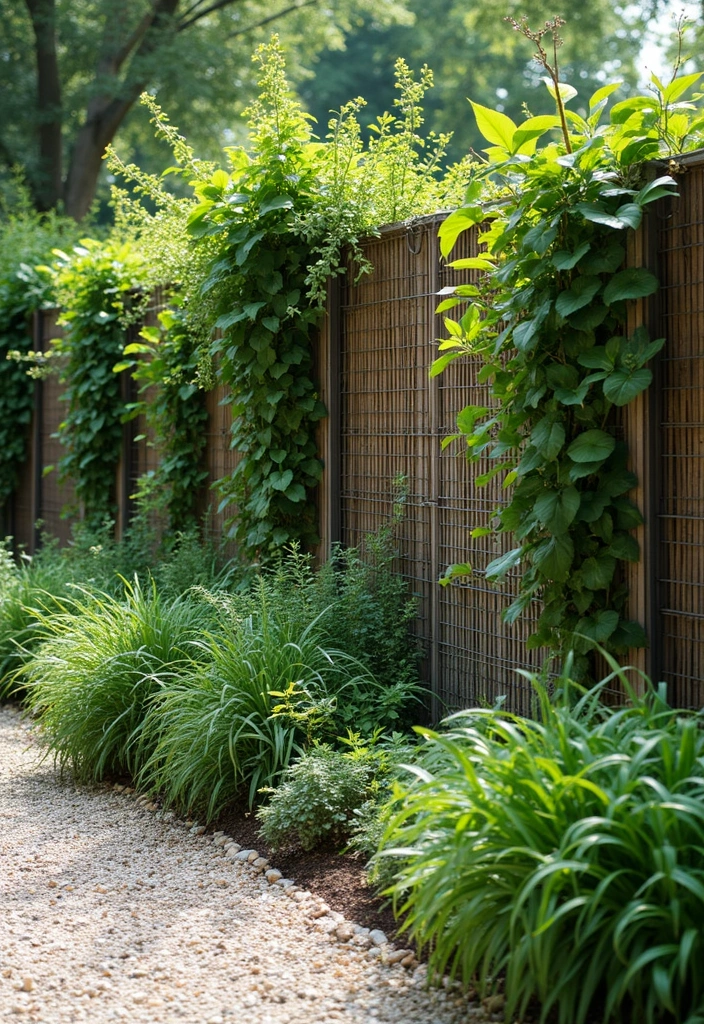
Wire fencing can be an excellent choice for those looking for a light and modern edging solution. Using materials like chicken wire or decorative wrought iron garden fencing can add a unique flair without feeling heavy or imposing in your garden.
You can use wire along pathways or around flower beds, allowing plants to peek through while maintaining the boundaries. This option is especially great for gardens that feature climbing plants; the wire can double as a support system.
For a polished look, consider painting the wire with something like garden wire paint to match your garden scheme, or opt to leave it bare for a more natural aesthetic.
Be sure to keep any edges smooth to prevent snags and ensure safety for pets and kids.
Wire fencing is not just a border; it’s a canvas! Let your plants peek through while keeping your garden stylishly defined with these creative garden edging ideas.
18. Bold Painted Stones
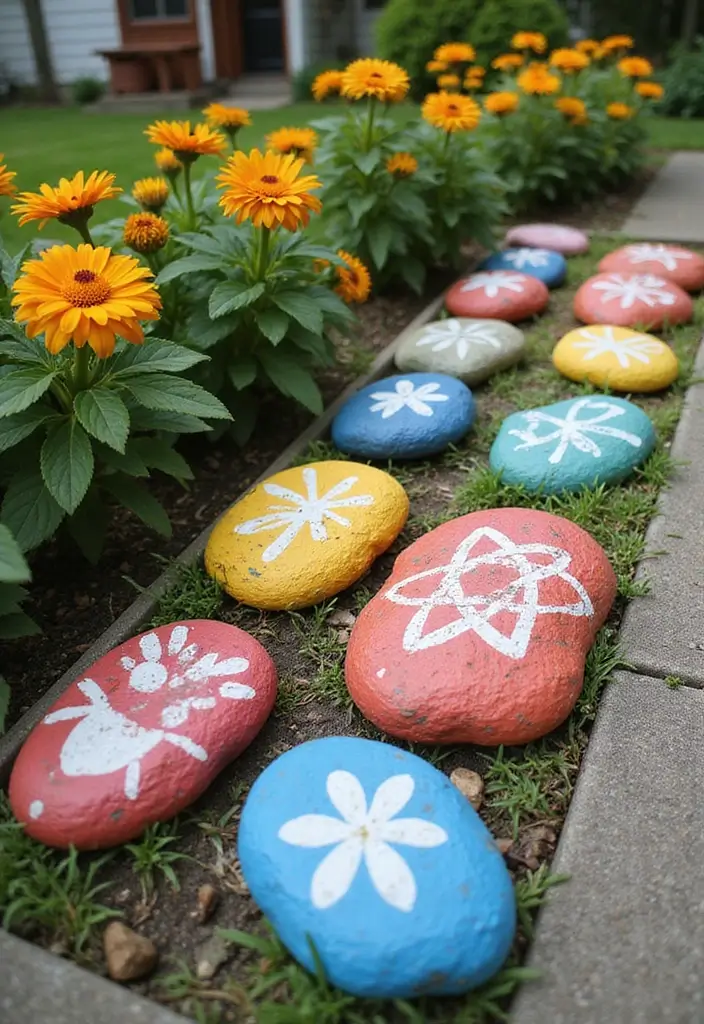
Painted stones can offer a whimsical and playful touch to your garden edges. You can paint them in bright colors, patterns, or even inspirational words to create an engaging border.
This DIY approach not only allows for creativity but also gives your garden a personal touch. Use large stones, such as large river stones, to create a prominent edge or smaller stones for a more delicate border. These hand-picked smooth stones are perfect for your artistic endeavors, whether you use them for edging or other decorative purposes.
Be sure to use outdoor paint like the outdoor acrylic paint set, which includes a variety of rich pigmented colors that can withstand the elements. This will ensure your stones remain vibrant throughout the seasons. Let your creativity shine; consider involving kids in the process for a fun family project. You might also want to grab a set of paint brushes for rocks, which are ideal for detailed painting and will make your decorating process much easier.
Besides being visually appealing, painted stones can serve as markers for specific plants or areas within your garden.
Let your garden tell a story with bold painted stones! Infuse creativity and personality into your space—each colorful rock is a reminder that your garden edging ideas can be as unique as you are.
19. Edgy Gabion Walls
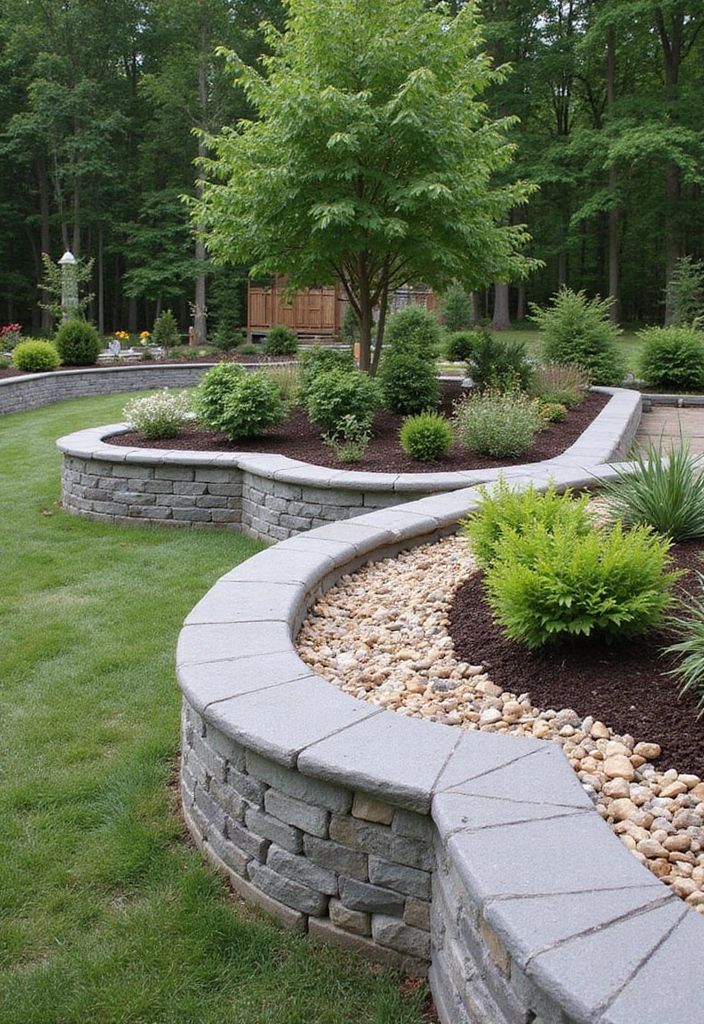
Gabion walls provide an innovative and sturdy option for garden edging using cages filled with rocks or stones. This design not only defines the garden space but also offers excellent drainage and stability.
You can customize the size and shape of the walls to fit your needs, whether low for a decorative touch or high for privacy. To get started, consider a gabion wall kit which includes galvanized wire cages, perfect for your garden projects. These sturdy, rust-proof cages will ensure your walls stand the test of time.
Gabions can be filled with a variety of materials, allowing for endless customization. For a beautiful and natural look, use locally sourced stones or opt for decorative rocks for gabions. A couple of pounds of polished gravel can enhance the aesthetic appeal of your walls while keeping costs manageable.
Additionally, you can plant succulents or vines in and around the gabion for added greenery throughout the year. An excellent choice would be a succulent plant assortment, providing a variety of potted plants that thrive in both indoor and outdoor settings. This modern approach integrates well with natural landscapes and complements a wide range of architectural styles.
20. Nature-Inspired Log Edging
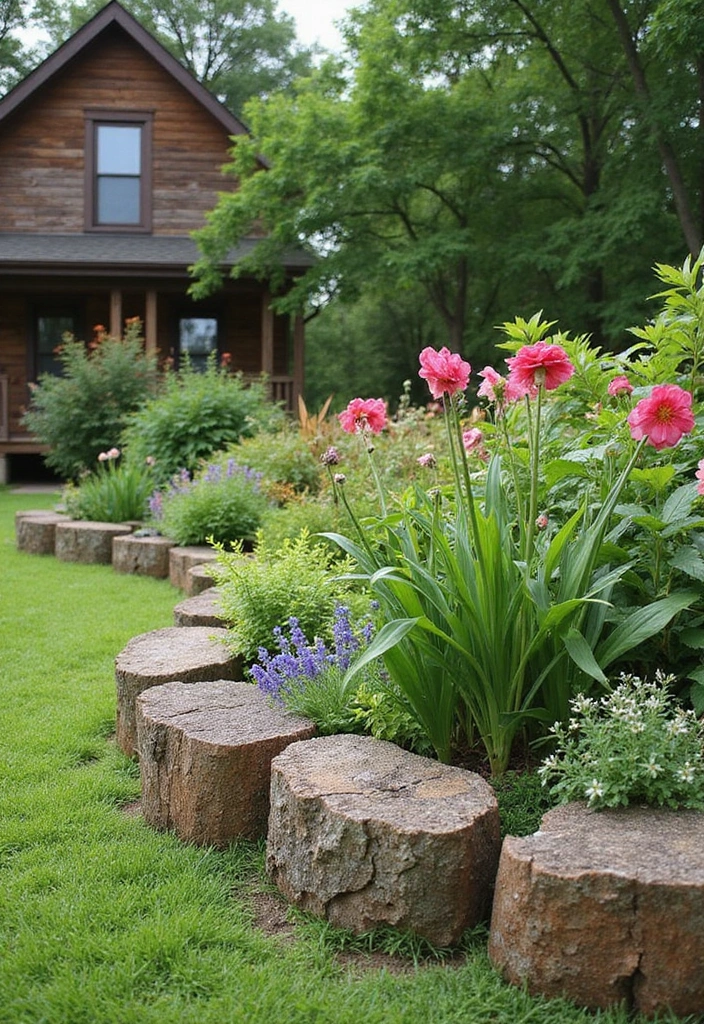
Log edging brings a rustic, woodland feel to your garden space. Using cut logs or stumps can create charming, natural borders that blend seamlessly with your landscaping. You can use them to define paths, create raised beds, or simply mark boundaries. This option works especially well in cottage gardens or spaces that aim for a more organic aesthetic.
To enhance the durability of your log edging, consider using a natural wood preservative like Garden Box Sealer. This plant-based wood sealant not only protects your logs from water and weather damage but is also safe for use with food plants, ensuring that your garden remains healthy and vibrant.
For those looking to incorporate functional elements, hollowing out a few logs can create unique planters for small flowers or herbs. If you’re not inclined to DIY, you might find the large hollow log planter a great option. This weatherproof, rustic piece adds both beauty and practicality to your garden.
Additionally, if you’re seeking ready-made options for your borders, consider using cut logs for edging. These solid eucalyptus wood logs are a perfect way to establish clean lines and natural separations in your landscape design.
Arranging the logs in varying heights can add dimension to your garden, enhancing visual interest while maintaining a natural theme. By using these products, you can easily create a charming and functional outdoor space.
21. Brightly Colored Pavers
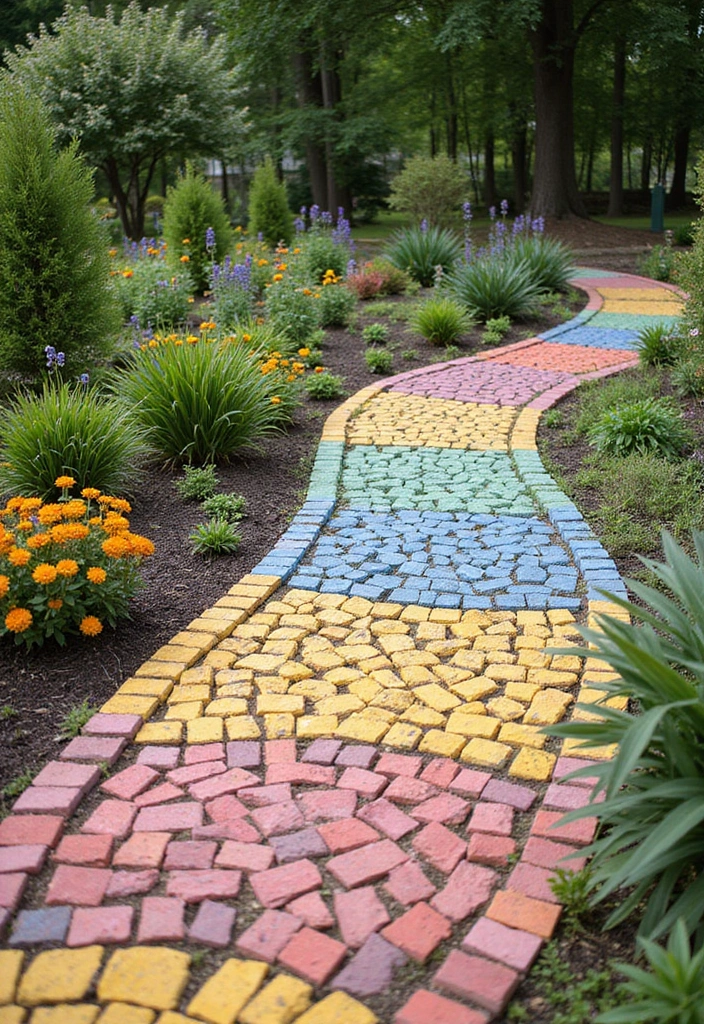
Pavers made from concrete or stone can come in a variety of colors, allowing you to create stunning edging around garden beds. You can lay them in geometric patterns for a stylish look that adds structure to your garden design. For instance, consider using geometric stone pavers, which come in interlocking tiles to give your outdoor space a modern edge while ensuring durability.
With options available in various sizes and shapes, you can get creative with the design while also providing solid footing in garden paths. To enhance your garden’s aesthetic, you might opt for colored concrete pavers, which can be arranged in unique layouts that reflect your personal style.
Mixing and matching different colors and patterns can give your garden a unique flair. You can also use pavers to create outdoor seating areas or fire pits that complement your garden’s overall look. To keep your beautiful pavers looking fresh and vibrant, regular maintenance is key. Consider using a paver cleaning kit for high power cleaning of concrete, brick, and paver surfaces, ensuring their longevity and brilliance throughout the seasons.
22. Cozy Fire Pit Edging
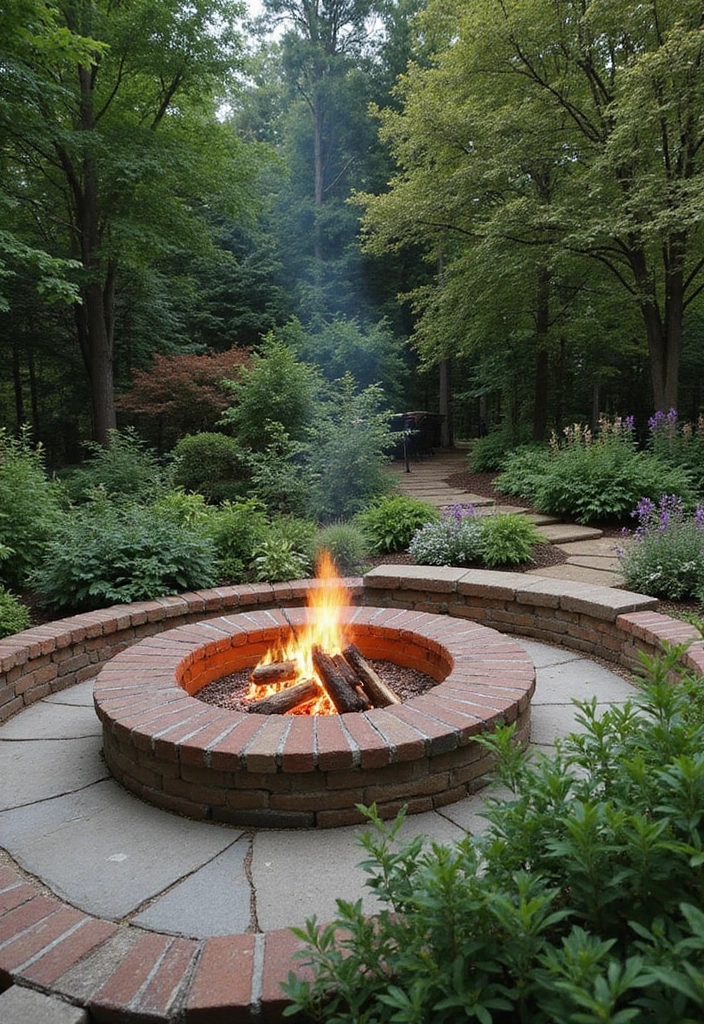
Fire pits can serve as a striking focal point in your garden while also providing natural edging. You can surround your fire pit with stones or bricks that define the area and create a cozy gathering spot. This setup not only adds warmth to your garden but also enhances outdoor living possibilities.
To achieve a polished look, consider using natural stone edging, like the EasyFlex No-Dig Landscape Edging. This decorative stone-look border can help to clearly delineate the fire pit area, blending beautifully with your garden’s overall theme.
Include seating around the fire pit, such as the stylish outdoor benches that feature an iron steel frame and mesh pattern. These benches provide a comfortable spot for guests to relax while enjoying the warmth of the fire.
To elevate the atmosphere, think about adding some fragrant herbs nearby, enhancing both the sensory experience and the functionality of your space. Additionally, incorporating outdoor string lights can create a magical ambiance during the evenings. With 100 feet of shatterproof vintage Edison bulbs, these lights will illuminate your fire pit area, making it an inviting spot for gatherings and ensuring that the charm continues long after the sun goes down.
23. Elaborate Tiered Edges
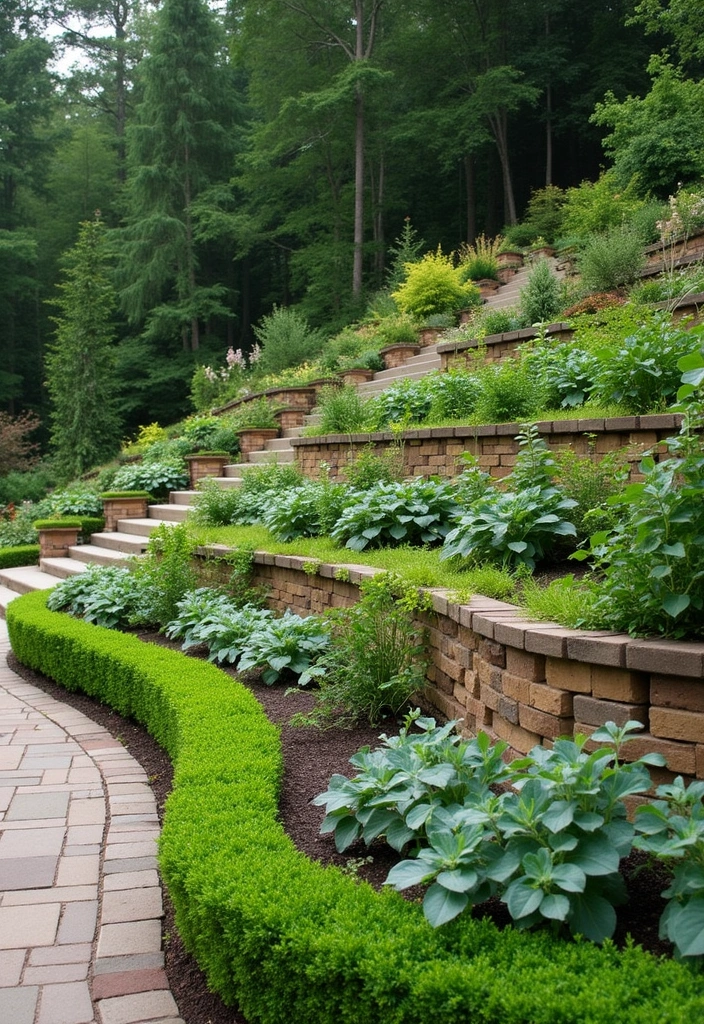
Tiered edging is a clever solution for gardens with elevation changes. By creating different levels, you can add visual interest while maximizing planting space. This design can be achieved using retaining walls, stones, or timber. For instance, consider using retaining wall blocks to create sturdy and attractive borders that help define each tier.
Tiered edges work particularly well for vegetable gardens, allowing easy access while defining spaces. You can enhance the design by incorporating steps or pathways that lead from one level to another. Adding garden timber edging can beautifully complement the natural landscape and create a seamless transition between different heights.
Incorporate different plants at each level so that each tier has its unique character and blooms at different times, ensuring year-round color. Consider planting herbs on the upper tiers for easy access while cooking. To fill in gaps and add texture, utilizing decorative gravel not only enhances the visual appeal but also helps with weed control, making maintenance a breeze.
Elevate your garden design with tiered edges! Not only do they maximize planting space, but they also create stunning levels of visual interest that invite exploration and joy. Dive into the art of garden edging ideas!
24. Unique Crate Borders
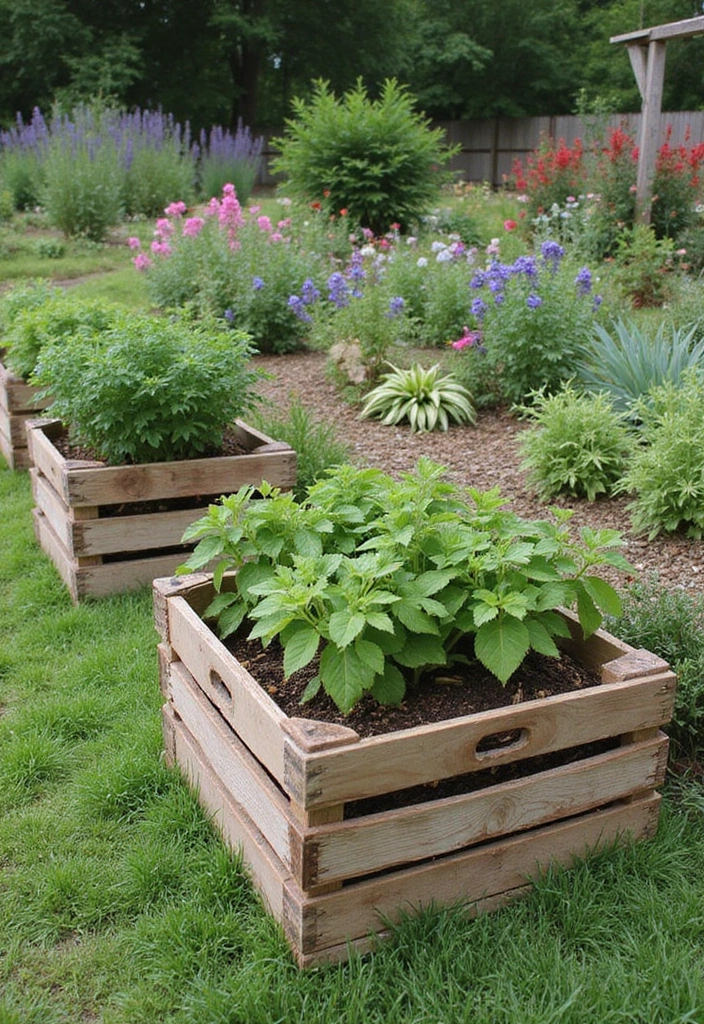
Crate borders offer a playful and creative way to define garden edges. Wooden crates can be repurposed as garden borders, adding a rustic twist while creating space for plants.
Stack them, place them upright, or lay them flat; the versatility is endless! This option allows for both an engaging visual element and a functional layout for your garden. To enhance your setup, consider using wooden crates for gardening that measure 17″ x 13″ x 8.9″ each, capable of holding up to 50 pounds. These spacious crates can be filled with soil to create unique raised beds while also serving as eye-catching borders.
You can paint or stain the crates to match your garden’s color scheme. A great choice for this is outdoor wood stain, like Varathane Premium Fast Dry Wood Stain in weathered gray, which gives your crates a beautiful finish and weather resistance.
Additionally, you can use the crates to store gardening tools or supplies, making them a functional addition. To keep your tools organized, a gardening tool storage box is a practical option that accommodates up to 78 tools, keeping everything you need within reach as you work in your garden.
Arranging crates in various patterns can create unique shapes, enhancing the charm of your gardening space.
Transform your garden with creative crate borders! Whether stacked or laid flat, these versatile accents not only define your space but also add a rustic charm that invites creativity and growth.
25. Living Edging with Plants
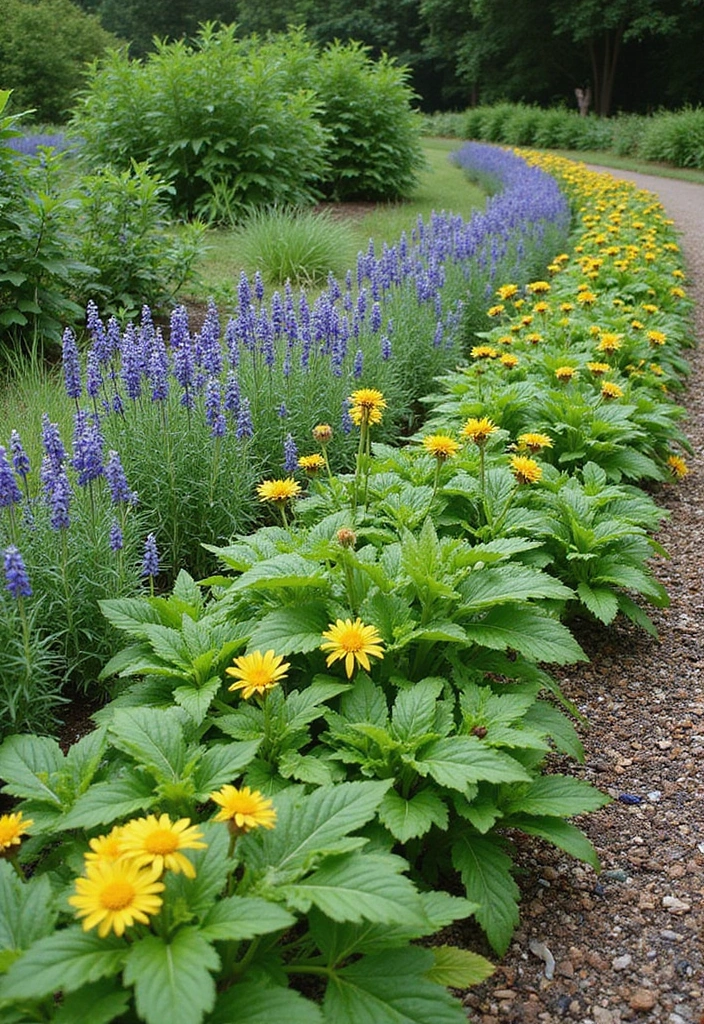
Living edging involves planting low-growing plants or herbs to create natural borders. This method not only is eco-friendly but also adds vibrant colors and textures to your garden.
Consider using lavender plants, which are known for their soothing aroma and ability to attract pollinators. These fragrant plants, growing around 6″ tall and 4″ wide, provide a lush edge and enhance the overall aesthetic with their soft purple hues.
Another excellent choice is creeping thyme. This perennial ground cover is not only a low-maintenance option but also offers beautiful purple flowers that bloom throughout the seasons. With over 20,000 seeds available, you can create a vibrant border that thrives in various conditions.
For added texture, consider incorporating ornamental grasses, like Calamagrostis a. ‘Karl Foerster.’ These grasses provide vertical interest and movement, while their yellow spikes contrast beautifully with flowering plants.
Ensure that the plants chosen are compatible with your climate and soil conditions for the best results. You can also mix and match colors and textures to create a unique border that evolves with the seasons.
Regular trimming and maintenance will keep your living edges looking neat and defined while enhancing the visual appeal. By choosing the right plants, like lavender, creeping thyme, and ornamental grasses, you can create a stunning natural border that brings life to your garden.
Conclusion

Defining your garden space can be both a functional and creative endeavor with the right edging choices. From charming wood to sleek metal, the options are endless, each adding its unique touch to your outdoor haven.
As you embark on your garden design journey, consider how each edging idea can reflect your personal style while enhancing your landscape. Embrace these inspirations to create a garden that is not only beautiful but resonates with your creative spirit.
Note: We aim to provide accurate product links, but some may occasionally expire or become unavailable. If this happens, please search directly on Amazon for the product or a suitable alternative.
This post contains Amazon affiliate links, meaning I may earn a small commission if you purchase through my links, at no extra cost to you.
Frequently Asked Questions
What Are Some Popular Materials for Garden Edging?
When it comes to choosing materials for your garden edging, you have a variety of options. Some popular choices include stone, wood, metal, and brick. Each material brings its unique aesthetic and functionality to your garden design.
For instance, stone borders add a rustic charm, while metal edging offers a sleek, modern look. Consider your garden’s overall style and what will best complement your plants.
How Do I Choose the Right Garden Edging for My Space?
Choosing the right garden edging involves considering both functionality and aesthetics. Think about how you want to define your space and what will work best with your existing landscaping.
If you have a more formal garden, brick or metal edging might suit your needs. For a more natural look, consider wood or stone. Additionally, be sure to think about maintenance and durability when selecting your materials.
Can I Use Recycled Materials for Garden Edging?
Absolutely! Using recycled materials for garden edging is a fantastic way to add character while promoting sustainability. You can repurpose items like old tires, broken bricks, or even wooden pallets to create unique borders.
This not only reduces waste but also allows for a personal touch in your garden design. Get creative and let your imagination guide you!
What Are the Benefits of Using Living Edging in My Garden?
Living edging, which involves planting low-growing plants or herbs to create borders, offers several benefits. Not only does it provide a clear definition of spaces, but it also enhances your garden’s biodiversity and visual appeal.
Additionally, living edges can attract beneficial insects and pollinators, and they often require less maintenance than traditional materials. Plus, who doesn’t love having fresh herbs at their fingertips?
How Can I Incorporate Curved Edging into My Garden Design?
Curved edging can add a soft, organic feel to your garden, making it feel more inviting and natural. To incorporate curved edging, consider using flexible materials like rubber or plastic that can bend easily.
Alternatively, you can use stone or brick arranged in a curve to create a more structured appearance. Just remember to plan your layout in advance to ensure a harmonious flow throughout your garden space.
Related Topics

